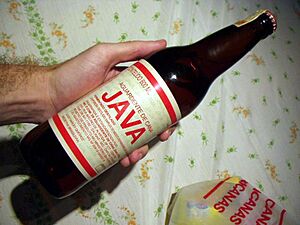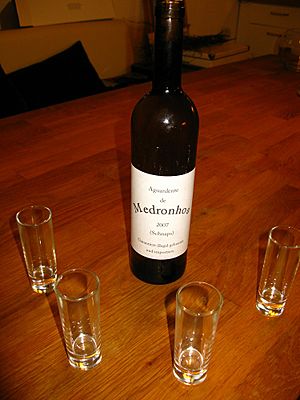Aguardiente facts for kids

Various bottles of aguardiente
|
|
| Country of origin | Colombia |
|---|---|
| Alcohol by volume | 29% to 60% |
Aguardiente (pronounced ah-gwar-DYEN-teh) is a general name for strong alcoholic drinks. The name comes from Spanish and Portuguese words. These drinks usually have between 29% and 60% alcohol. Aguardiente first came from Portugal and Spain. It is also very popular in countries in the Americas where Spanish and Portuguese are spoken.
Contents
What Does "Aguardiente" Mean?
The word "aguardiente" is a mix of two words from Spanish and Portuguese.
- Agua (or água) means "water."
- Ardiente (or ardente) means "burning" or "fiery."
So, "aguardiente" means "firewater"!
What is Aguardiente?
Aguardientes are strong drinks made by a process called distillation. This process takes fermented liquids from sweet fruits, grains, or vegetables.
- Fruit-based aguardientes can be made from oranges, grapes, bananas, or even a fruit called medronho.
- Grain-based ones might use millet, barley, or rice.
- Tuber-based aguardientes come from plants like beet, manioc, or potato.
- Sugarcane is also a common ingredient for "true" aguardientes.
There are two similar drinks from sugarcane: cane aguardiente and cachaça.
- Cane aguardiente is made from sugarcane that has already been used to make sugar. It usually has 38% to 54% alcohol.
- Cachaça is made directly from fresh sugarcane juice. It has 38% to 48% alcohol and can have a little sugar added.
Rules for Aguardiente
Governments in places like Spain and Portugal have rules for how aguardientes are made. These rules make sure the drinks are made only from specific natural ingredients. They also make sure no extra alcohol or flavors are added. Many types of aguardiente have special names that protect where they come from. For example, "Aguardente de Vinho Douro" is a wine spirit only from the Douro region.
Aguardiente Around the World
Different countries and regions have their own special ways of making and enjoying aguardiente.
Brazil
In Brazil, a popular drink called cachaça is made from sugarcane.
- There are two main types: white and gold.
- White cachaça is bottled right after it's made. It's often used in mixed drinks like caipirinha.
- Gold cachaça is aged in wooden barrels. It's usually enjoyed on its own.
The flavor of cachaça comes from how it's made and the type of wood used for aging.
Cape Verde
In Cape Verde, the local aguardiente is called Grogue. It's also made from sugarcane. Most of the sugarcane grown there is used to make this drink.
Chile
In Chile, aguardiente is made from the leftover parts of grapes after winemaking. This includes the skins, pulp, stems, and seeds. It usually has 45% alcohol or more. People use it to make other flavored drinks. For example, murtado uses wild rose fruit, and enguindado uses dried cherries. It can also be flavored with mint, walnuts, or almonds. People often drink it plain or use it as a base for a drink called cola de mono.
Colombia
In Colombia, aguardiente is a popular drink flavored with anise. It's made from sugarcane. Each region in Colombia has its own right to make it. Different amounts of anise give it different flavors. Colombian aguardiente usually has 24%–29% alcohol. It's very popular in the Andean mountains of Colombia. People usually drink it plain, not mixed in cocktails.
Costa Rica
In Costa Rica, the aguardiente is called Guaro. It has 30% alcohol and a neutral taste. The government in Costa Rica carefully controls its production.
Guam and the Mariana Islands
In Guam and the Mariana Islands, a drink called aguajente is made from distilled coconut palm wine. It was once very common among the Chamorro people.
Ecuador
In Ecuador, aguardiente is also made from sugarcane. It's usually not flavored. People drink it plain or mix it with cinnamon and fruit juices to make a hot drink called canelazo. Another hot drink, draquita, mixes it with naranjilla juice and spices. Locally made aguardiente is called punta, "puro," or trago. Its alcohol content can vary a lot. Aguardiente is the most popular strong alcoholic drink in Ecuador.
Mexico
In Mexico, aguardiente has many names, like habanero. In the state of Michoacán, charanda is a traditional sugarcane aguardiente that is similar to rum.
Portugal
Portugal has several kinds of aguardiente.
- Aguardente vínica is made from wine. It's often used to make wines like Port stronger, or it's aged to become aguardente velha, which is a type of brandy.
- Aguardente bagaceira is made from the leftover grape skins and seeds after wine is made. It's a way to use all parts of the grapes. People often drink it with coffee, calling it café com cheirinho ("coffee with a little scent"). In the Azores, this is called café com música (coffee with music).
- Aguardente Medronho is made from the fruit of the Arbutus unedo tree.
In Madeira, most aguardiente is made from sugarcane. It's a key ingredient in a drink called poncha.
Spain
Galicia is famous for its aguardientes.
- Augardente de bagazo is made from distilled grape leftovers. It's clear and strong, often over 50% alcohol. Many villages still make it the traditional way.
- Augardente de herbas is a yellow, sweet drink made with augardente de bagazo and herbs like chamomile.
- Licor café is a black, sweet drink made with augardente de bagazo, coffee, and sugar.
- Crema de Augardente is a creamy liqueur similar to Irish cream, made with augardente, coffee, and milk.
In some parts of Spain, aguardiente is made from the squeezed skins of grapes after winemaking. This basic drink is called orujo or aguardiente. It's often mixed with herbs, spices, or fruits.
United States
During the early history of California, aguardiente was made from mission grapes. It was a popular drink during the Gold Rush of 1849.
See also
 In Spanish: Aguardiente para niños
In Spanish: Aguardiente para niños



